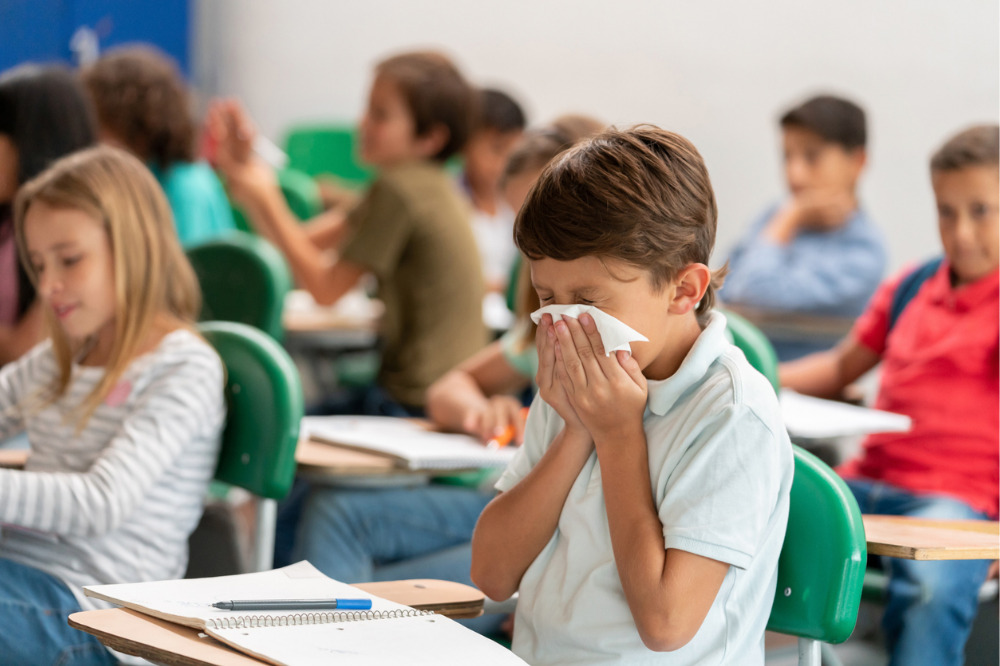
This week, students in NSW and Victoria are finally returning to the classroom after extended lockdowns.
While the return to face-to-face learning has been a relief to many parents, students and teachers, some senior school leaders are worried that the government’s back-to-school model might be setting schools up for another crisis.
More than 300 schools across NSW and Victoria have closed down in the last three weeks alone due to Covid-19 outbreaks. One of them was Berwick Lodge Primary School in Melbourne, which recently had an outbreak of 18 cases on its campus. The incident sent 37 staff and 106 students into self-isolation.
Principal, Henry Grossek, says almost half of his school’s parents are refusing to send their kids back because of potential exposure.
“While remote learning might not have been the best approach for some people, we at least had certainty and predictability. We knew what we were doing every day. We also knew that the risk was lower because kids were at home,” Grossek told The Educator.
“Now that we have more freedoms, we have no predictability. Covid transmission is happening through kids – not parents – which is contrary to what some media outlets have been saying.”
Grossek said it is “sometimes better to work with a routine you don’t like better than one where if everything goes right it’s good but if everything goes wrong, it’s disastrous”.
He pointed to the upcoming Christmas holidays, which may see families isolated from one another due to a spike in the number of outbreaks.
“It’s heartbreaking to imagine that after waiting so long to reconnect with each other, people across the state could again be separated because of a government policy to send kids back to school when a large number of them remain unvaccinated and vulnerable”.
A growing body of research suggests kids may not be as protected from the virus as previously thought.
A recent study of 110 children aged two weeks to 21 years who tested positive for COVID-19 found that children and adolescents are equally capable of carrying high levels of live, replicating COVID-19 variants.
The researchers said most children are asymptomatic or only mildly symptomatic when they develop COVID-19, giving the misconception that children are less infectious.
A separate study of 6,804 young people aged between 11-17 found that up to 1 in 7 children may have symptoms linked to the coronavirus months after testing positive for COVID-19. The researchers found that those who tested positive to COVID-19 were twice as likely to report three or more symptoms 15 weeks later than those who had tested negative.
A backward step in Covid-Safe protections?
Meanwhile, there are also concerns that the recent lifting of restrictions means Victoria’s public schools are not as safe and sanitary as they were under the government’s Covid-Safe regulations that were in place during hybrid learning arrangements.
“As far as I’m aware, we haven’t seen an air purifier delivered yet and there don’t appear to be any carbon dioxide monitors either. The only weapon we have is to open doors and windows, but we’ve always had this,” he said.
“There is also the issue that we’ve gone from deep cleaning back to normal cleaning. This means classrooms are less sanitary than what they were – and from next week, all kids will be back in classrooms, not just some.”
This concern was also highlighted recently by NSW teachers, who questioned whether the decision by the new Premier, Dominic Perrottet, to bring forward the date that schools reopen was premature.
The NSW Teachers Federation (NSWTF) president, Angelo Gavrielatos, said the failure to get all teachers double vaccinated in time for the face-to-face return of schools “lies squarely at the feet of the government which refused to prioritise teachers in the vaccination rollout”.
“While there is an encouraging take up rate of vaccination for 12-15 year olds, many 12-15 year olds will not be vaccinated at the time of return. As for under 12 year olds there are still no vaccinations available,” Gavrielatos told The Educator.
“Significant risks remain for unvaccinated students who might get infected and transmit the virus to their families, each other and beyond.”
Back in Victoria, Grossek said the feeling among many teachers and leaders is one of concern over celebration as students return to the classroom.
“Right now, it feels like we’re jumping from the frying pan into the fire,” Grossek said.
“We all want the kids back, but I don’t want them back on site if it’s going to cause greater problems than if they were learning at home.”


